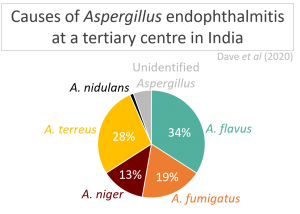Submitted by Aspergillus Administrator on 17 December 2009
Aspergilloma are characteristically balls of fungi contained within cavities in tissue. Most commonly this is in lung tissue, often thought to be formed in pre-existing cavities as most patients seem to have a history of lung damage e.g resulting from tuberculosis.
Aspergilloma can be treated with antifungal medication but this is usually as a way to contain the fungal ball rather than to try to eradicate it – the ball can be very resistant to systemic medication and a cure often requires its complete removal.
Why is a fungal ball so difficult to penetrate? One reason is possibly that there is no circulation of blood through the ball so there is nothing to carry the drug into the ball. Another reason is becoming clearer as the latest research starts to offer clues.
Many micro-organisms are known to secrete a tough slimy substance under some growth conditions and to aggregate together to form a biofilm (see fig). Some are known to do that in response to antibiotics, as if there is some protection to be had from this structure.
It has been known for some time that Aspergillus fumigatus forms a biofilm when growing on an agar surface (Beauvais et al., 2007). This paper shows that the biofilm is produced at the surface of an aspergilloma while growing within the human patient. The fungal ball largely consists of what look like dead fungal hyphae with some viable cells at the periphery of the ball – the structure of the dead hyphae are reminiscent of fungi that have used up all available nutrients and died.
Could it be then that the ability to get an antifungal drug within the fungal ball is not as important as it would be to just penetrate the surface as most of the deeper lying cells are already dead?
Why isn’t this happening already as that is where the richest blood supply exists already?
One reason is that the biofilm slime is notoriously impermeable to antifungal drugs – once we can get antifungals through that barrier we might be making headway.
Loussert et.al. show that A.fumigatus growing on an agar plate produces a different biofilm slime compared with when it is growing as an aspergilloma. When it grows within a lung as an aspergilloma it produces extra components. When it grows as an invasive aspergillosis (not as a ball) it produces a biofilm slime but the slime is different when compared with that associated with an aspergilloma.
Biofilms are well known to have a role in resistance to antifungals (d’Enfert. 2006) so perhaps they are performing the same function for aspergillomas? Careful attention is needed to assess which antifungal drugs are better at penetrating the type of biofilm secreted by an aspergilloma, and which are likely to penetrate the slime produced by an invasive aspergillosis.
News archives
-
Title
Date



